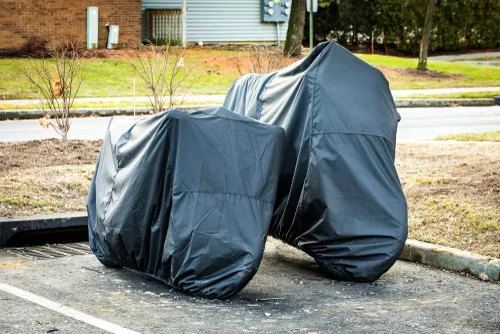How to Store Your Motorcycle in a Self-Storage Unit

Your motorcycle is a significant investment, not to mention a ton of fun. If you’re leaving town for a long time or storing your bike during colder seasons, it’s worth considering a self-storage unit for your motorcycle to offer added protection.
Leaving your motorcycle in a self-storage unit doesn’t mean simply parking it in a garage. If you don’t take certain steps beforehand, you risk damaging the body and mechanics of the bike.
This article will walk you through how to store your motorcycle in a self-storage unit to ensure it stays in tip-top shape while it’s there.
Choose the Right Storage Unit
If you’re only storing your motorcycle for a short period of time in mild, dry weather, an outdoor storage option may work. Be aware that your bike could get bumped by other people or their property - make sure the self-storage location offers the right amenities for your motorcycle.
Outdoor storage costs less than indoor storage, but if you’re in a climate that’s rainy, snowy, pest-ridden or near salty ocean air, the damage to your bike won’t be worth the savings.
For most motorcycles, a 5-foot by 10-foot self-storage unit should be big enough for one bike, its cover and any gear you wish to store, such as helmets and jackets. Some people choose a climate-controlled unit to keep their motorcycle and gear in optimal conditions.
Other things to consider as you select a self-storage option:
- Do the security and amenities meet your needs and expectations?
- Is drive-up access available, even for some interior units?
- Do the access hours work with your schedule?
Gather Important Documentation
Come prepared to prove that the bike is yours. Documents you’ll need may include:
- Vehicle registration
- Proof of insurance
- Title
Prepare Your Motorcycle for Storage
Before you leave your motorcycle at the self-storage unit, make sure it’s prepared to stay in good shape while it’s there. Begin by checking the owner’s manual for storage guidelines.
Understand that your motorcycle must be in running order to be stored, and you may not work on it while it’s on the property. The following steps can be modified whether you choose outside storage or a self-contained unit.
Prepare the Gas Tank
Empty the gas tank completely; storing gas inside a storage unit is not allowed, nor are any other hazardous materials.
Top Off Fluids
Fill up the brake, clutch and coolant fluids to prevent oxidation and engine damage. If you are in a cold climate, add antifreeze as well (if your storage unit isn’t climate controlled).
Add a fogging oil to the front stationary tubes, bouncing the front wheel to make sure it’s well distributed.
Treat Individual Components
A few pieces of your motorcycle should get specific attention:
- Lube the chain and throttle and clutch cables.
- Change the filter.
- Remove, clean, oil and replace electrical components.
Protect the Body and Tires
Wash and thoroughly dry the motorcycle to remove any potentially damaging residues. Add a coat of quality wax to resist moisture. Treat leather or vinyl seats with appropriate conditioners to prevent drying and cracking.
Fill the tires to their capacity, understanding they will lose some of that pressure over time. Some sources recommend overinflating the tires but beware of overinflating them so much that they explode.
Leaving Your Motorcycle in the Storage Unit
Remember, you may not work on your motorcycle while it’s in the self-storage unit, so do as much prep as you can ahead of time. However, a few things need to be done when you are finished riding (unless the motorcycle is being delivered on a different vehicle).
Protect the Motorcycle Body and Mechanics
Make sure the motorcycle is totally dry and free of dust to prevent rust, mold and build-up in the components. Block up or cover the exhaust pipe to deter pests. Never run the motorcycle with the exhaust blocked or the unit door closed.
Remove the battery and bring it home to keep it warm, as it can crack in cold temperatures. Connect it to a trickle charger/battery tender to maintain the charge. If you don’t remove the battery, charge it completely and run the motorcycle at least once a month to keep the battery from draining.
Preserve the Tires
As mentioned, the tires should be as inflated as possible. Even then, flat-spotting (flattened, weakened spots in the tires from prolonged pressure) is possible. Avoid flat-spotting by removing the tires and setting the motorcycle on a lift or the bike’s center stand.
Use a Good Cover
A high-quality cover will keep debris and moisture off your motorcycle. It will also prevent scratches if something else in the unit tips over onto your bike. Better yet, you can use the cover all year-round to protect the motorcycle from sun damage and the weather. Never use a plastic tarp, as it can trap moisture and scratch the body.
Lock it Up in a Secure Storage Unit
Finally, secure your self-storage unit with a good lock. Motorcycles can be tempting to thieves, and even if your storage facility has excellent surveillance and security, a durable lock is a must for absolute protection. Also, look for storage facilities that have 24-Hour Video Recording/Surveillance like at our Haledon, New Jersey location and other self storage locations.
Now that you know how to store your motorcycle in a self-storage unit, also know that Storage Post offers a range of options that could work for your bike. Contact the location nearest you to learn what we have for your motorcycle.
Up To Two Months Free!
For a limited time, get up to two months rent free* on selected units.